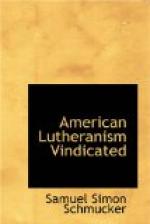(d) The doctrine of the real presence of the true body and blood of Christ, contradicts the clear and indisputable testimony of our senses, for as the body and blood are to be received by the mouth of the communicant, they must be circumscribed by space, and the reception must be a local and material one, which if it did occur at sacramental occasions, could be observed by the senses.
(e) It contradicts the observation of all nations and all ages, that every body or material substance must occupy a definite portion of space, and cannot be at more than one place at the same time.
For these and other reasons the great mass of our ministers and churches, connected with the General Synod, reject this doctrine, as inconsistent with the word of God. The disposition to reject this error, or at least to leave the mode of the Saviour’s presence undecided, was manifested by Melancthon himself, as is evident from his having stricken out the words which teach it from the Augsburg Confession, and from his having inserted others in their stead of a general nature, leaving room for different opinions on this question. The same disposition prevailed extensively in Germany in the latter third of the sixteenth century. But during the first quarter of the present century, the conviction that the Reformers did not purge away the whole of the Romish error from this doctrine, gained ground universally until the great mass of the whole Lutheran Church, before the year 1817, had rejected the doctrine of the real presence. During the last twenty years the doctrines and writings of the Reformation in general have been the subject of extensive study by the reviving church in Germany, and as is natural, a small portion of the churches have embraced the symbolic view of this doctrine in full, and have become known as Old Lutherans, whilst others, both there and in this country, have embraced various modifications of it. But the great body of the ministers and churches regard the real presence of the body and blood of the Saviour, in any proper sense, which the words convey, as a misapprehension of the word of God.
The supposed special Sin-forgiving Power of the Lord’s Supper.
On this subject, important as it is, especially to the masses of the less educated, who are most liable to these erroneous views, but little need be said in addition to the principles established on the subject of the sacraments in general. The word of God clearly inculcates the doctrine, to which Luther and his coadjutors gave such prominence, that no one can be justified or pardoned except by a living faith in Christ, and such a faith is found only in the regenerate mind. And whenever the sinner exercises this living faith in Christ he is justified, that is, his sins are pardoned, he is in a state of justification, and continues in it, until by deliberate, voluntary violation of God’s law, he falls from grace.




